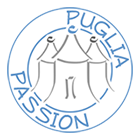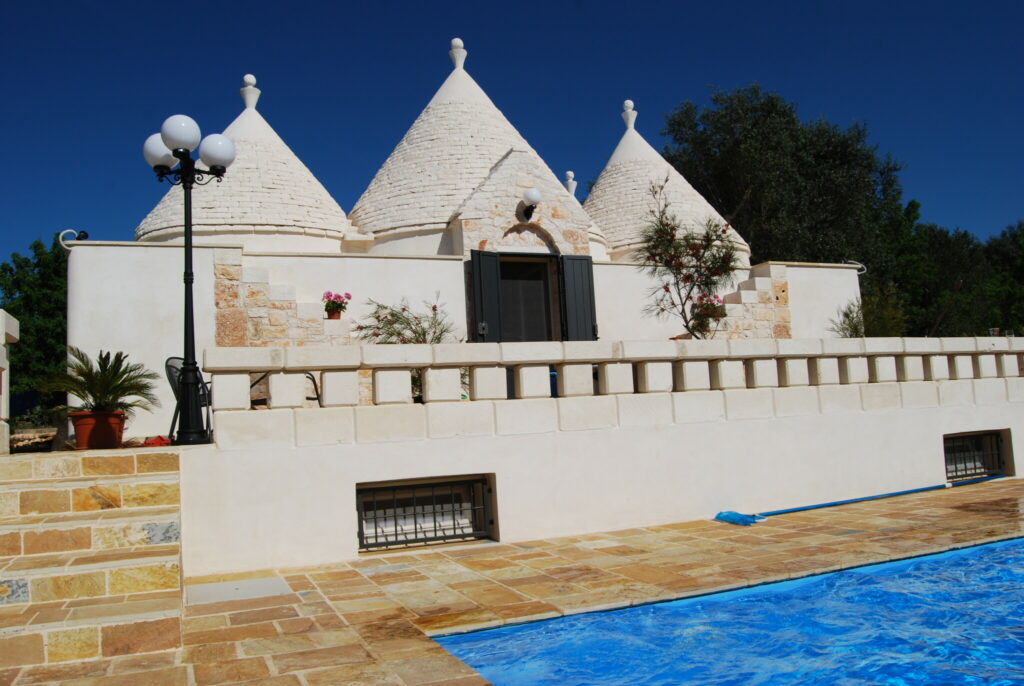Wednesday: 10.00 - 12.30/15.30 - 18.00
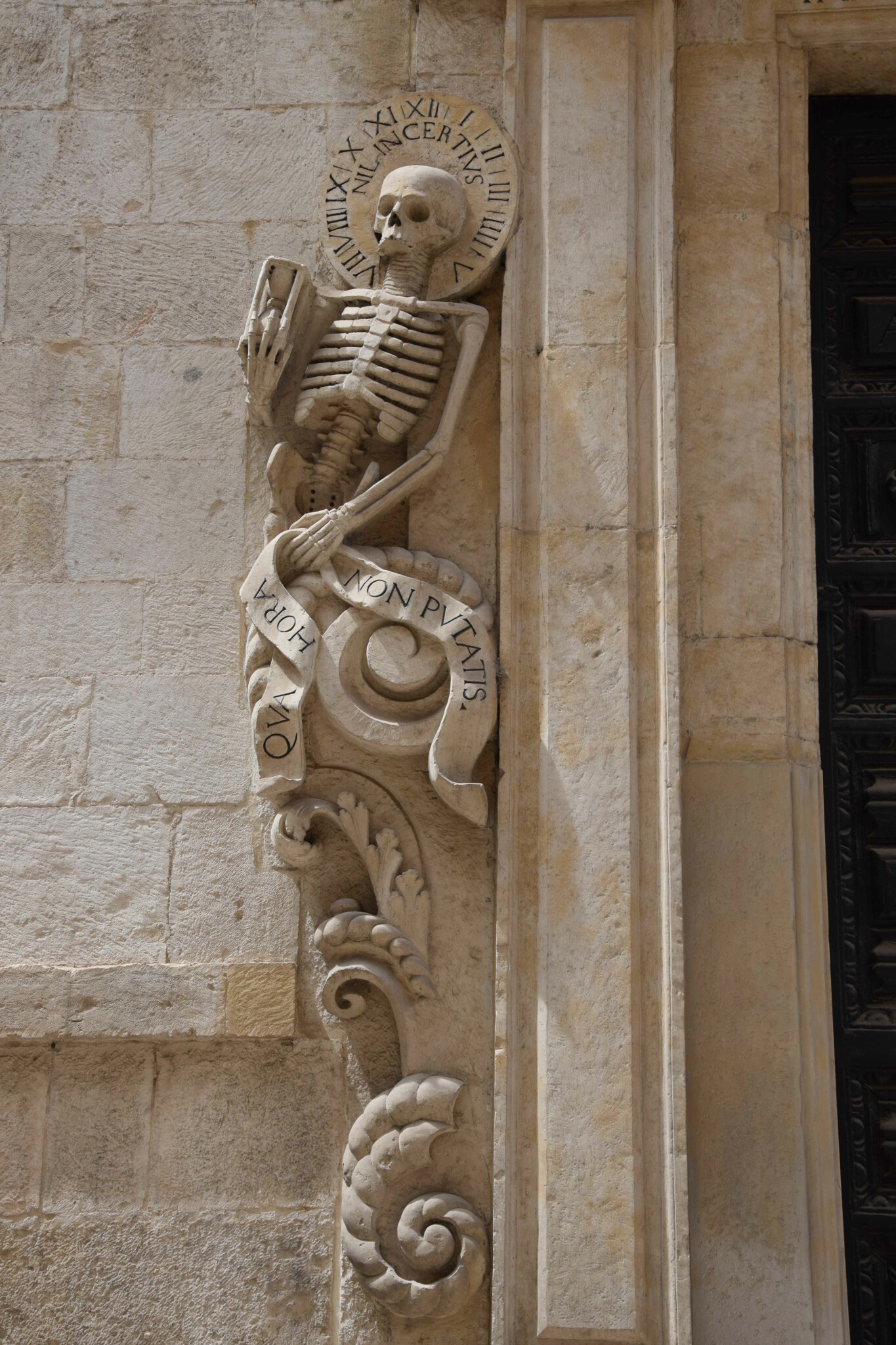
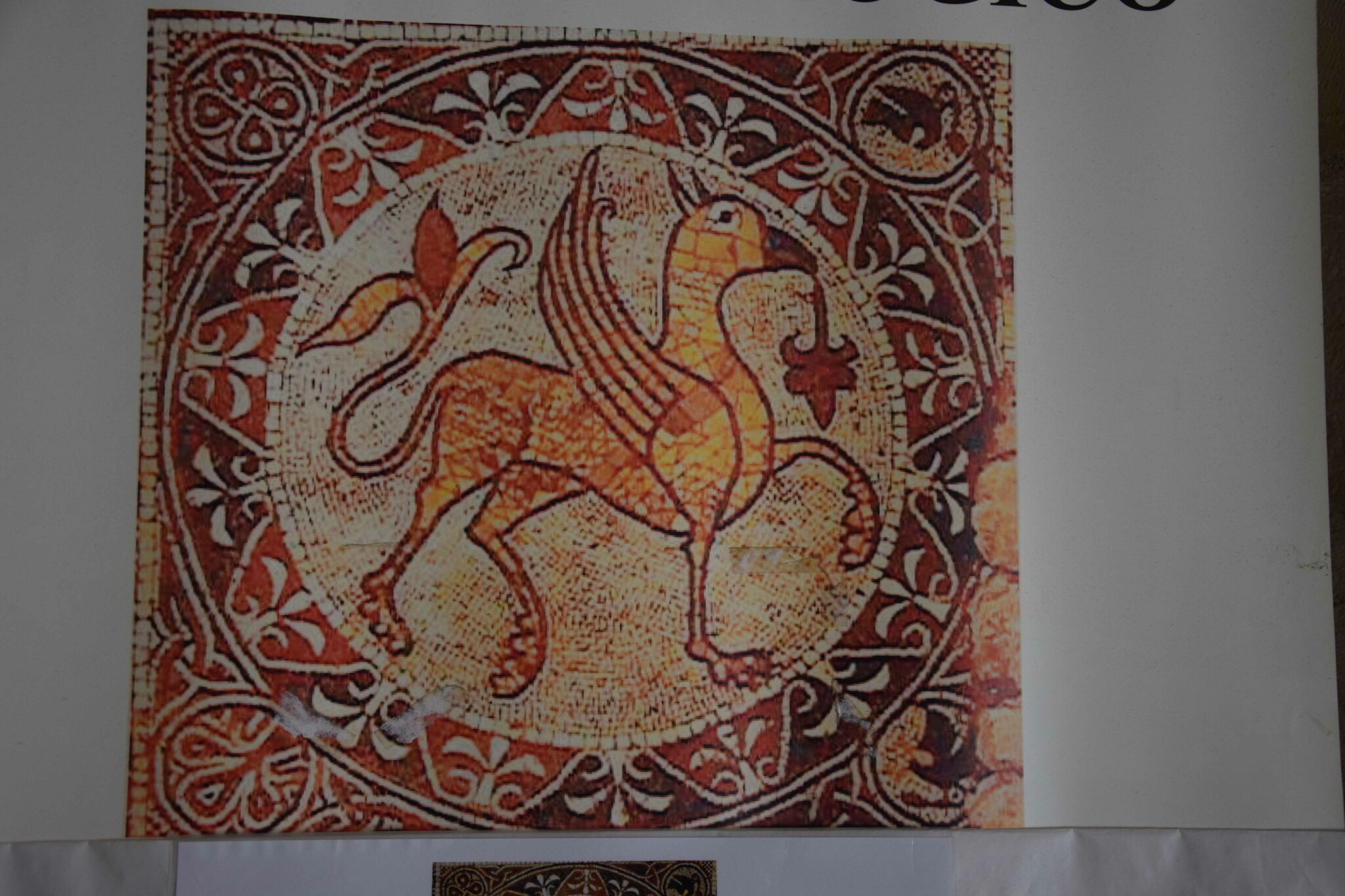
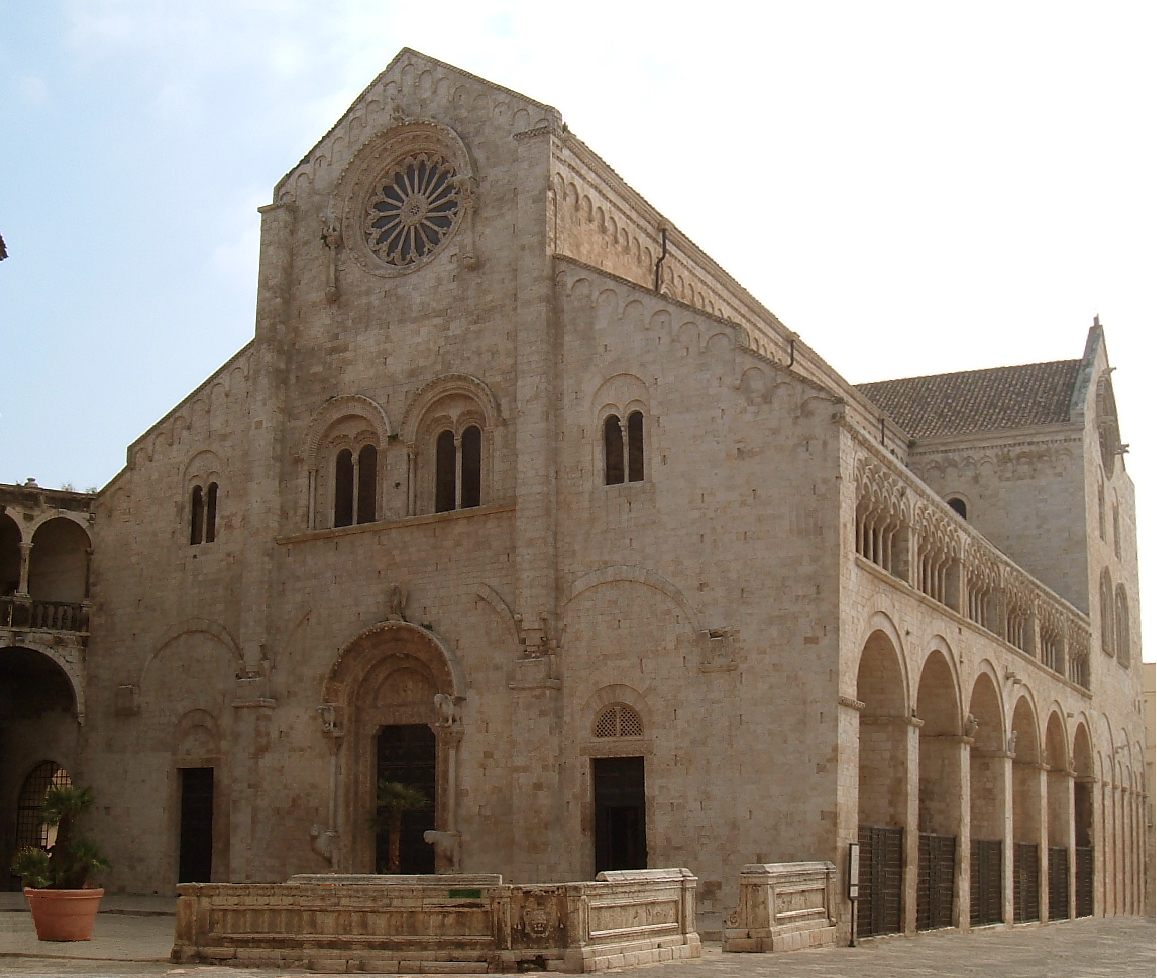
Bitonto is a significant city, population 55,000, about 11 kilometres west of Bari. It has an attractive borgo vecchio ("old town") with many renaissance aristocratic residences; numerous churches, one of which is Puglia's largest cathedral; and one of Puglia's most significant and well organised art galleries.
The city is very accessible, located close to the A14 autostrada and about half an hour from Bari by the local metropolitan train. It is especially easy to reach from Bari Airport, by road or a couple stops by train; this means it is an excellent spot to start or finish a trip to Puglia if travelling via this airport.
Visitors by car will find plenty of places to park around the edge of the central area. Those arriving by train should alight at Bitonto station (not Bitonto SS Medici) and walk straight ahead along Via Matteotti; it is a 5-10 minute walk to the city centre, but plenty of places to stop and have a coffee on the way!
At the heart of Bitonto are three piazze adjacent to one another - Piazza Moro, Piazza Marconi, Piazza Cavour. The last of these is the most interesting and the main focus for visitors.
History/Battle of Bitonto
Bitonto was founded by the Peucetii, and according to myths was named after the Ilyrian king Botone. Evidence has been found of the original city walls, dating back to the 4th Century BC. Bitonto's main claim to fame historically however is for the Battle of Bitonto in 1734, during the War of the Polish Succession. In this war, the Spanish Bourbon King Philip V took the opportunity to invade the Italian peninsula aiming to eliminate the Austrian Hapsburgs who then held the Kingdom of Naples and Sicily. This resulted in a significant victory for the Spanish army over the retreating Austrians, and led quickly to the final collapse of Hapsburg rule in southern Italy. The Bourbon dynsasty became the recognised rulers of the area under the Treaty of Vienna in 1738. An obelisk just outside the centre of the city was shortly afterwards erected as a permanant record of this important battle.

Porta Baresana
Right in the middle of Bitonto is the Porta Baresana (formerly called Porta della Marina), an ornamental arch which was once a major gateway through the long-ago demolished city walls. Today it separates Piazza Cavour from Piazza Moro and Piazza Marconi, acting as the entrance to the borgo vecchio.
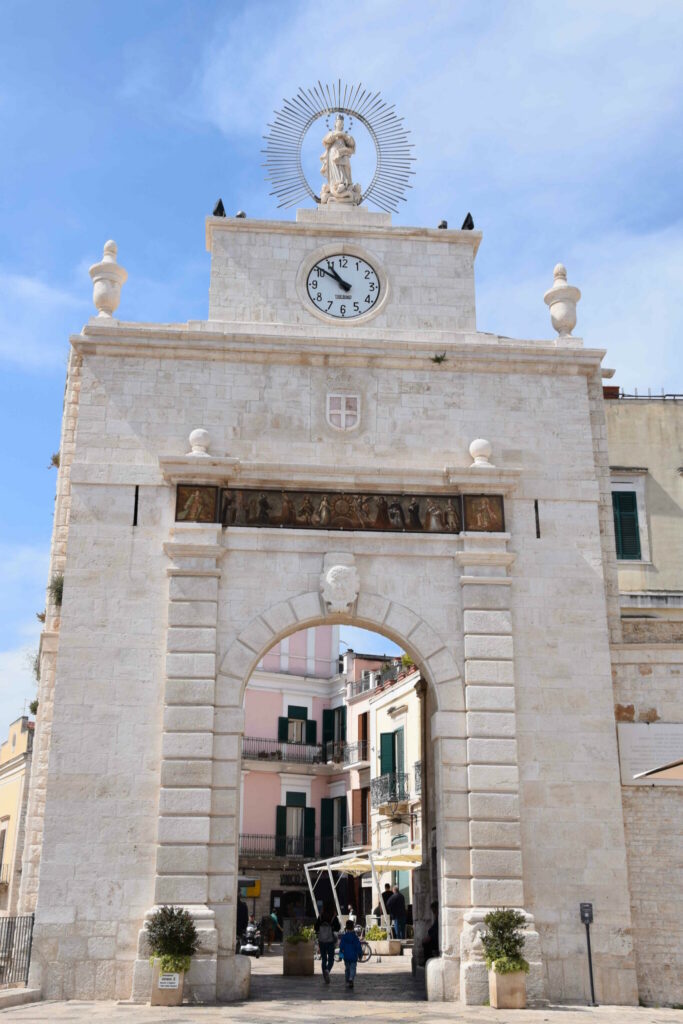
This was originally built in the second half of the 16th century, but due to damage in conflicts it was rebuilt in the Renaissance style in the early 17th century. The chimes of the clock which surmount the gateway are especially evocative. The statue of Santa Maria Immacolata was added on top in 1834, the 100th anniversary of the Battle of Bitonto (reputedly it was this saint who saved the town from being destroyed by the Spanish commander as he retreated).
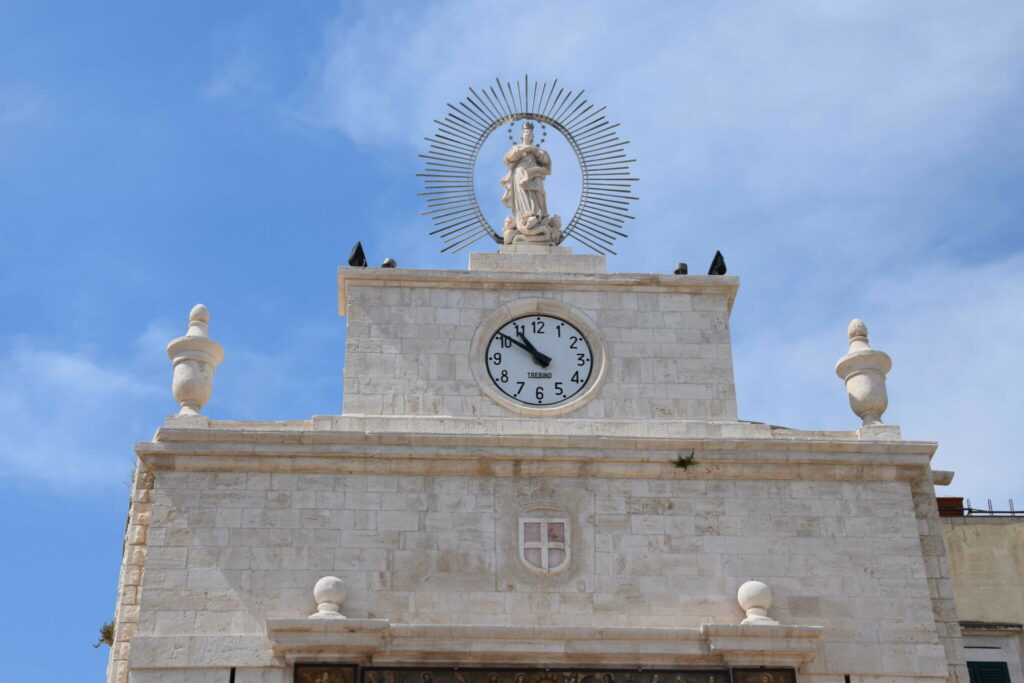
Torrione Angioino
Next to the Porta Baresana is a cylindrical moated tower, the Torrione Angioino, or Anegevin Tower. This imposing structure, 16 metres high, sometimes referred to as the castello or castle of Bitonto, is the last remaining of 28 towers which formed part of the old city walls. It was the largest and most solid of these towers, built in 1380-1384. In recent years it has been the subject of various excavations, which recovered the moat around its base and various other features. A Gallery of Contemporary Art now occupies part of the building, reached by a narrow footbridge across the moat - we have never found this open however. It is of course possible to view the Torrione from the outside, it dominates one end of Piazza Cavour and is a major feature of Bitonto.
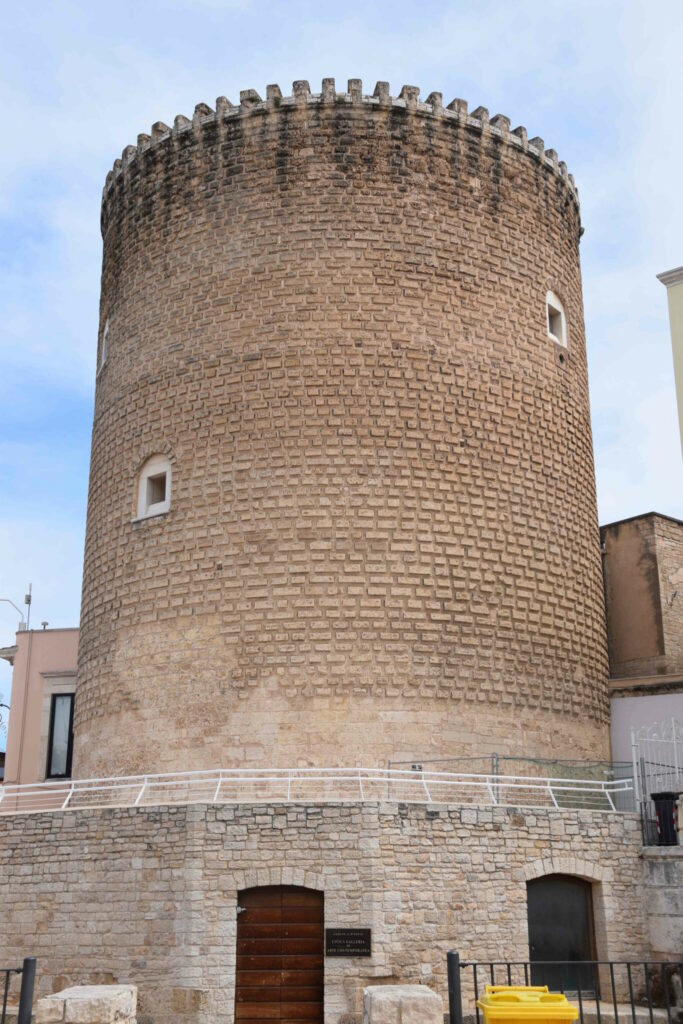
Palazzo Sylos-Calo/Galleria Nazionale di Puglia Girolamo e Rosaria Devanna.
Overlooking the other side of the Piazza Cavour is the arched loggia of the Palazzo Sylos-Calo. This is the largest and most important of several imposing and ornate renaissance residences in the borgo vecchio of Bitonto.
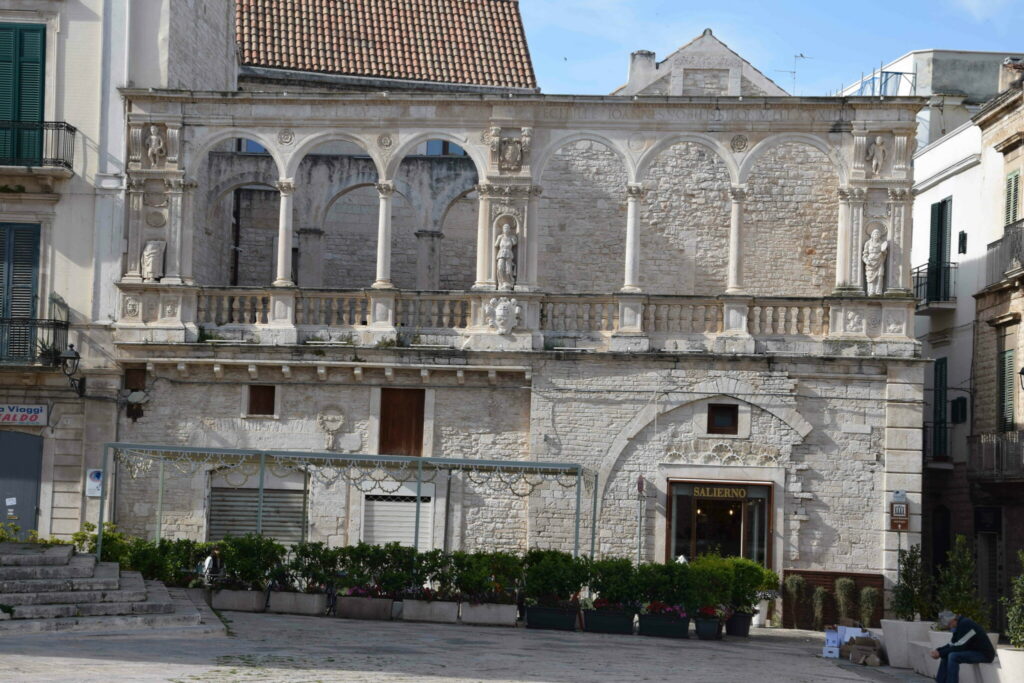
Since 2009, this palazzo has housed one of Puglia's most important art galleries - the Galleria Nazionale di Puglia Girolamo e Rosaria Devanna.
This is a "must see" for anyone visiting Bitonto with even a slight interest in Italian art and culture. The gallery is on three floors of the palazzo, spatious and well organised; unlike so many art galleries there are plenty of seats. The collection is based on the legacy of the wealthy original patrons. Highlights include paintings by El Greco, Velasquez, Poussin. Renaissance works by Negroni, Titian and Veronese are featured. A large number of 17th century works include paintings by Orazio and Artemisia Gentileschi and many other leading artists. The 18th century is represented by well known artists of the Neapolitan school, but also other important European artists including Tiepolo. From the 19th century section there are works by internationally famous painters, including in particular Delacroix; but also by many significant Italian artists ncuding Puglia's own Guisppe de Nittis from nearby Barletta.
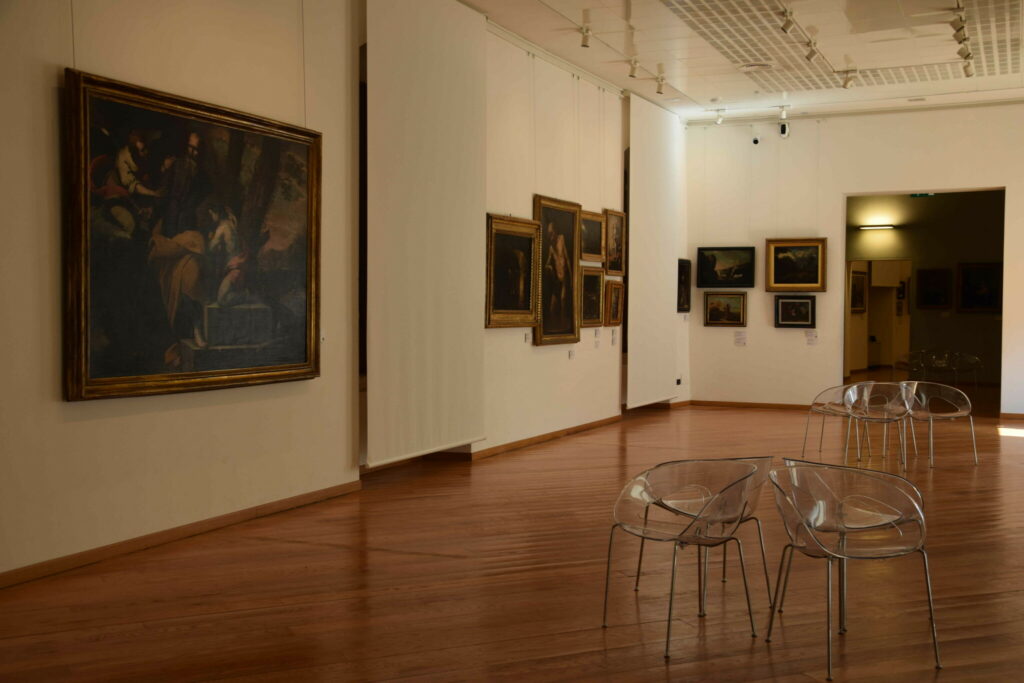
The entrance to the palazzo and galleria is just off Piazza Cavour, along Via Rogadeo. The palazzo was constructed in 1529-1538 for a leading local family of nobility, the Vulpano family. Its imposing gateway features the coat of arms of the Stylos family, later owners of the building. Inside the entrance area is an open colonnaded courtyard with stairs to two upper storeys.
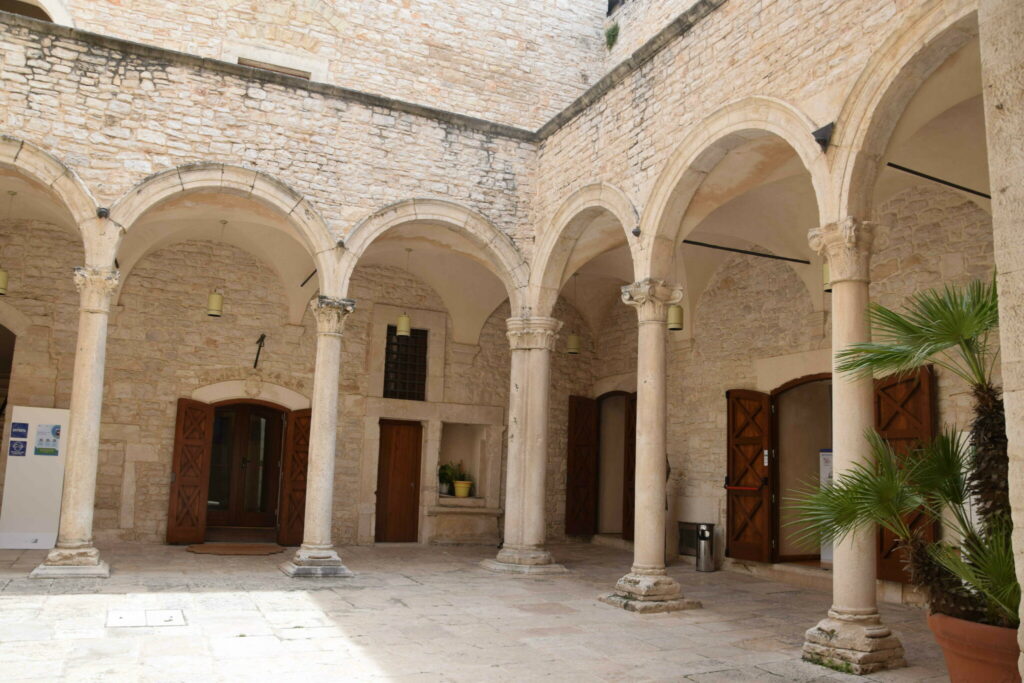
There is no entrance fee (oddly you do have to obtain a ticket) and it is open every day from 8.30am-3.00pm, although some published details of opening hours suggest it is closed on Mondays. A slight disappointment is that the loggia overlooking Piazza Cavour is not usually open to visitors.
Borgo Vecchio/Chiesa del Purgatorio
You penetrate the narrow streets of the borgo vecchio by continuing along Via Rogadeo beyond the Palazzo Stylos-Calo. On the right you will spot the doorway of the Chiesa del Purgatorio, which is simply part of the street frontage. This church was built in 1670. It is rarely open except for services; so if you want to go inside try on a Sunday. However, the doorway and frontage is decorated with amazing carved figures of skeletons, symbols of death and animals associated with the horrors of purgatory. It all looks quite scary, and maybe best to avoid it at night!
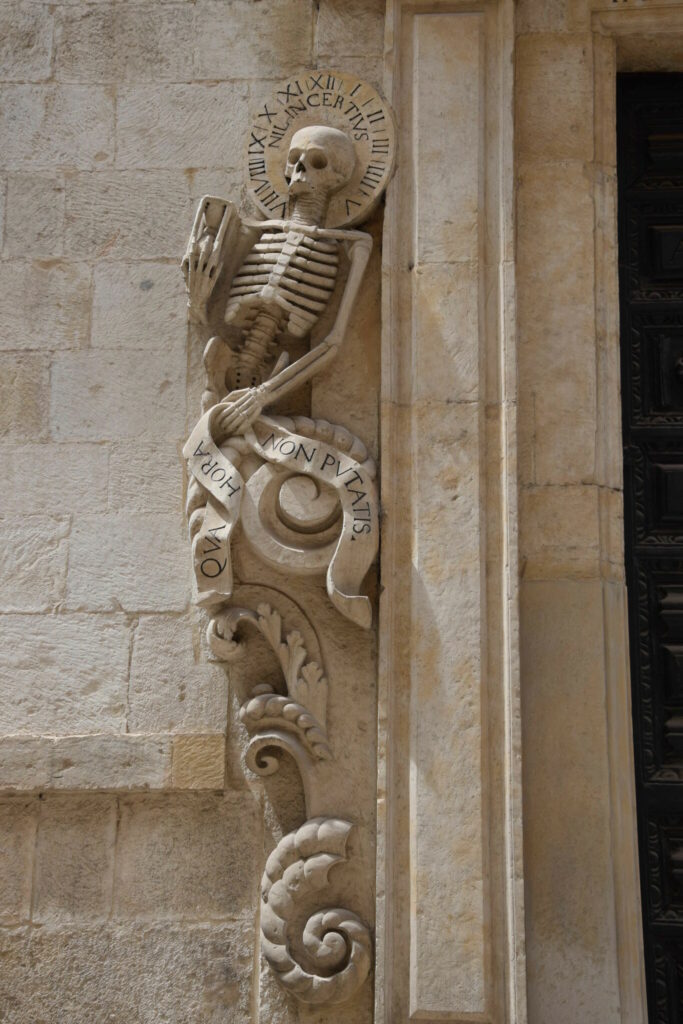
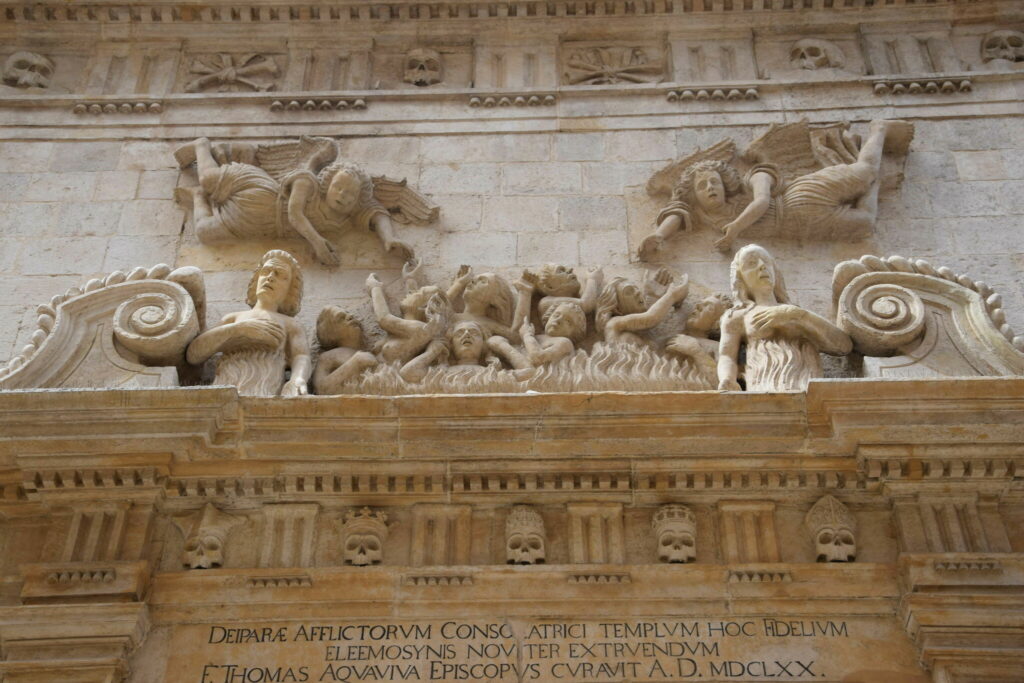
Piazza Vescovada
A little further on, through an archway, is the Piazza Vescovada, a quiet square on the rear side of the enormous cathedral. It has an old well in its centre, and is enclosed by various ecclesiatical buildings.
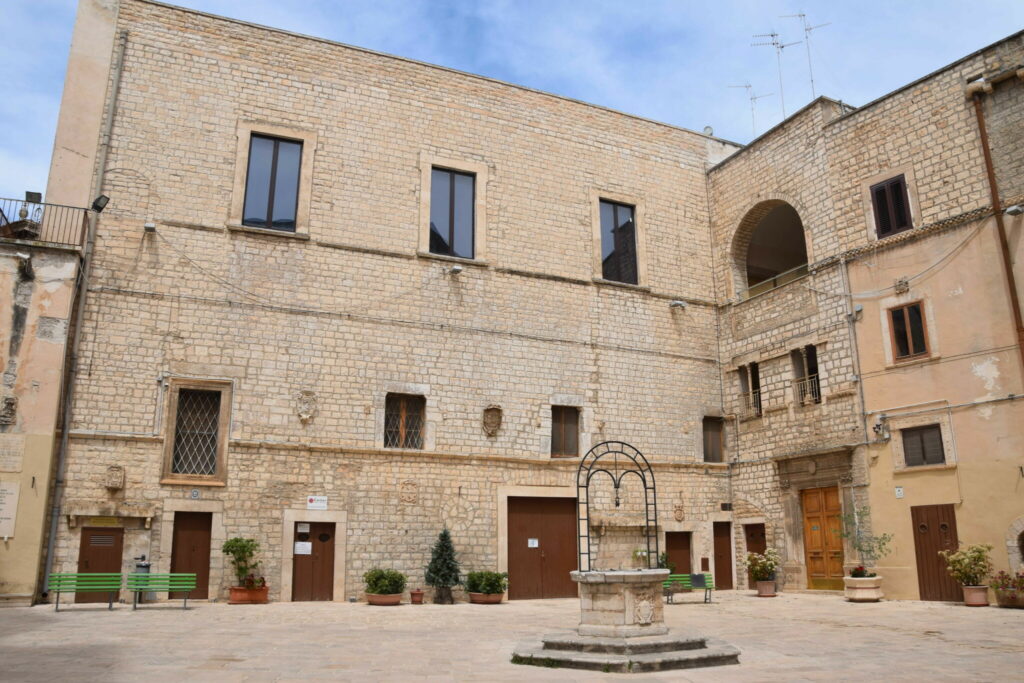
Bitonto Cathedral
Walking around the end of the cathedral from this piazza, you enter the Piazza Cattedrale. The enormous size of the cathedral can be best appreciated from here.
The cathedral of Bitonto is dedicated to Maria Santissima Assunta. (It is sometimes referred to as the Cathedral of San Valentino, because it contains the arm of this saint as a relic). It is regarded as the most complex and fully expressed example of the Puglian Romanesque (Norman) religious architecture, dating originally from the 11th/early 12th century.
The west front, which can be seen from one end of Piazza Cattedrale, has three sections, each with a decorated entrance. A rose window is flanked by sculptures of animals on columns.
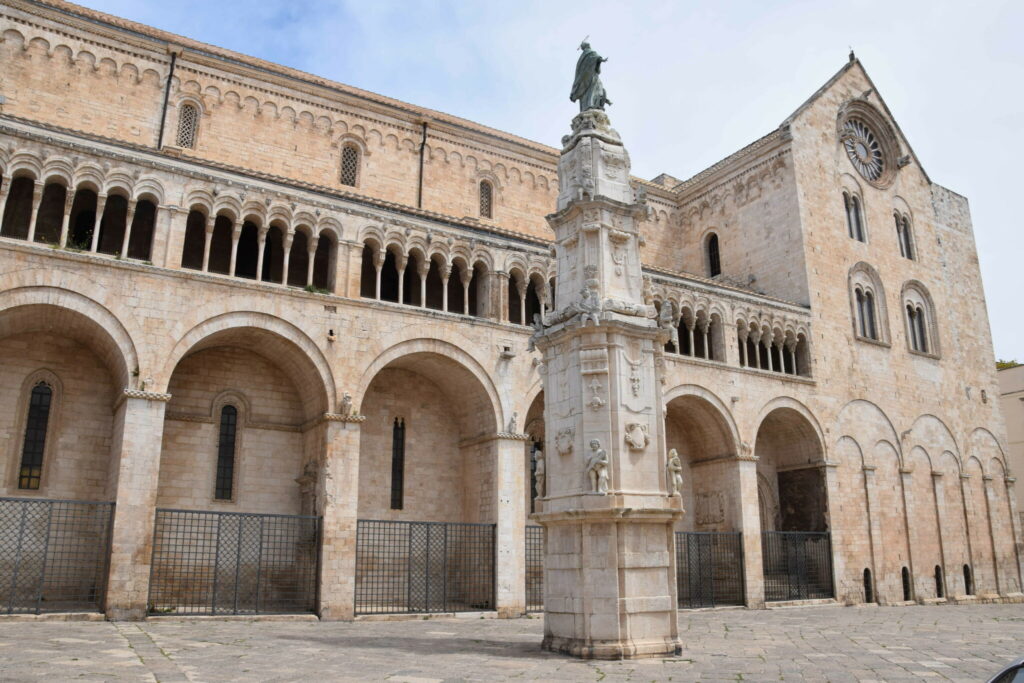
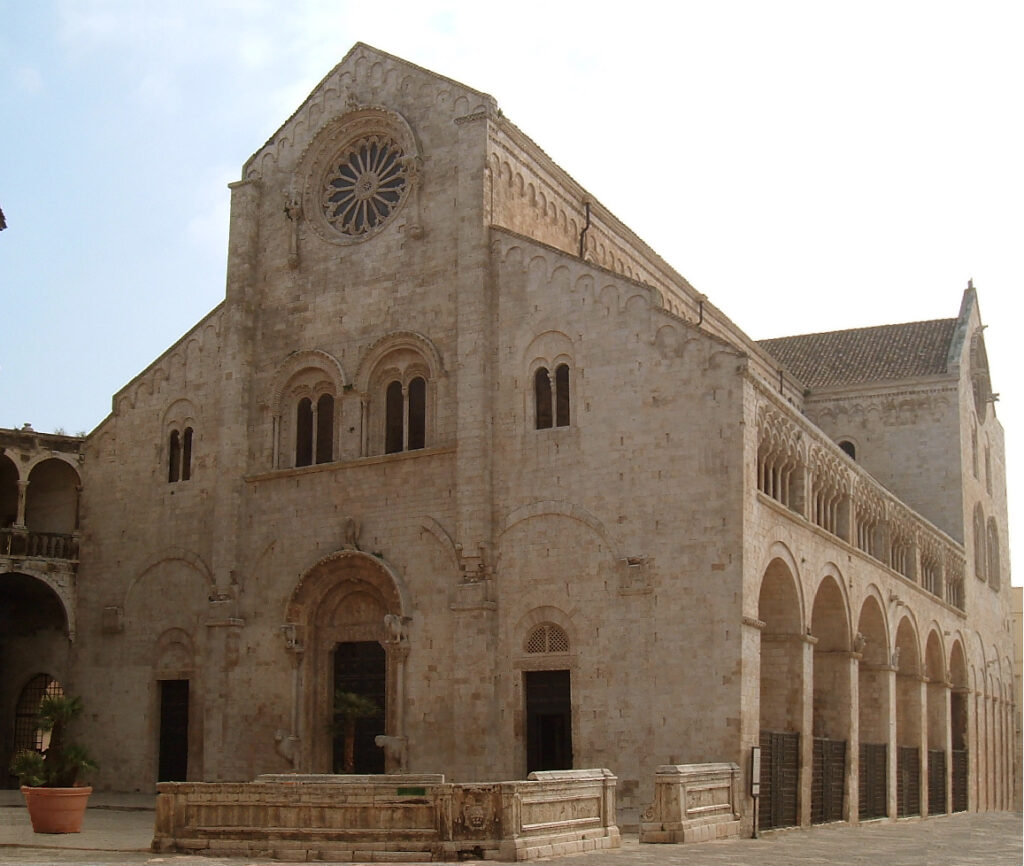
Inside, the cathedral ha a large nave and two aisles. There is a great deal of sculpture and decoration. Of particular significance is a stone-carved ambo, which is a comination of pulpit and lectern, dating from 1229; this piece of marble sculpture features an eagle, various fantastic animals and plants, very dramatic and inspiring.
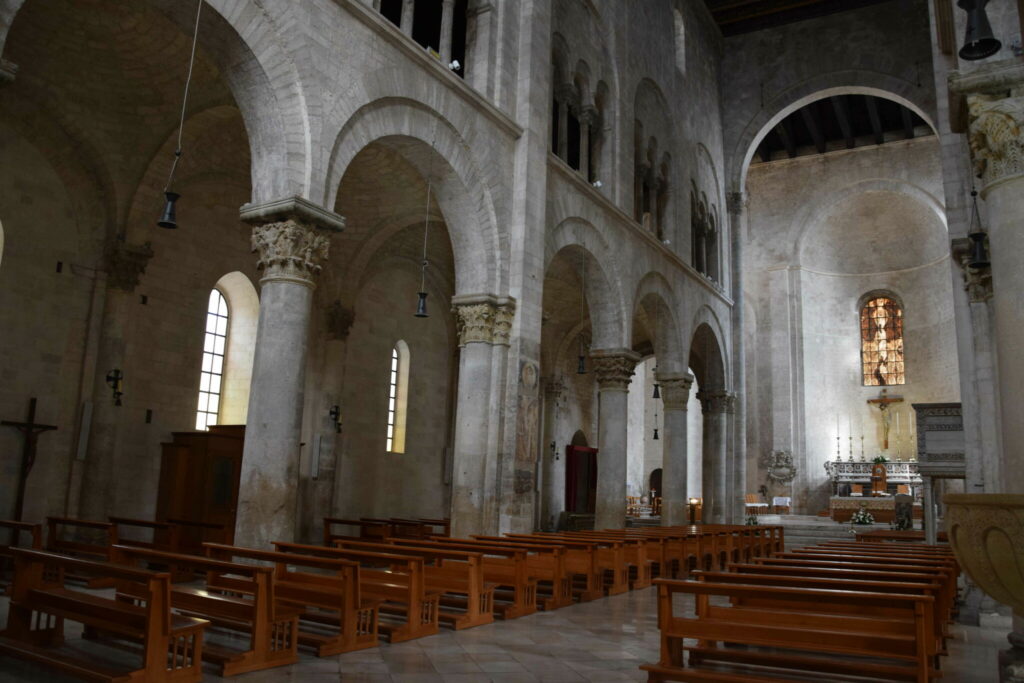
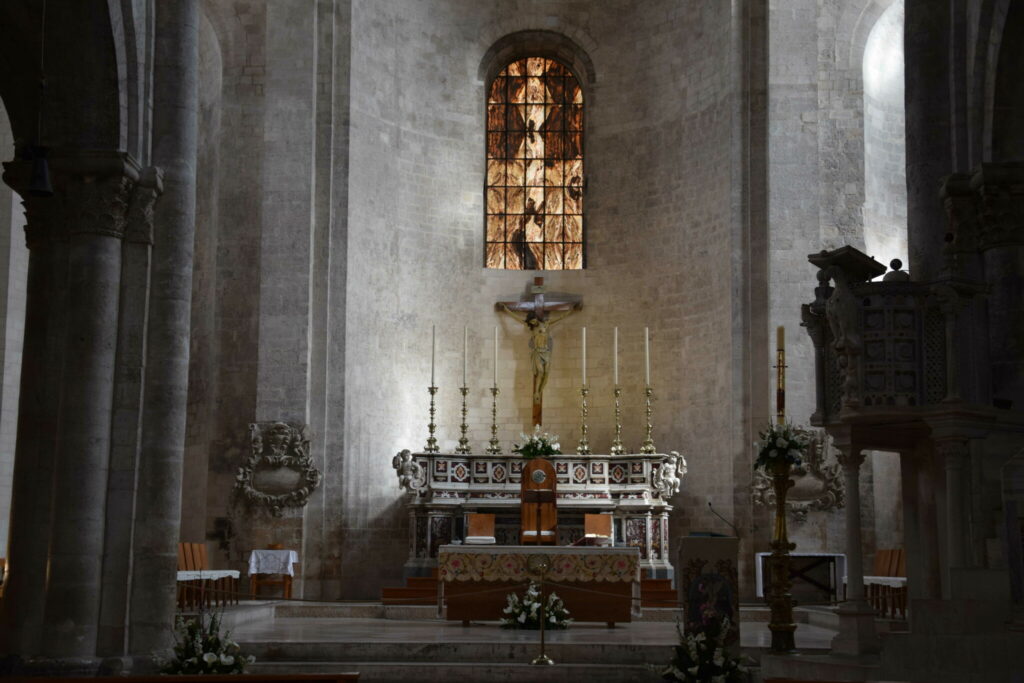
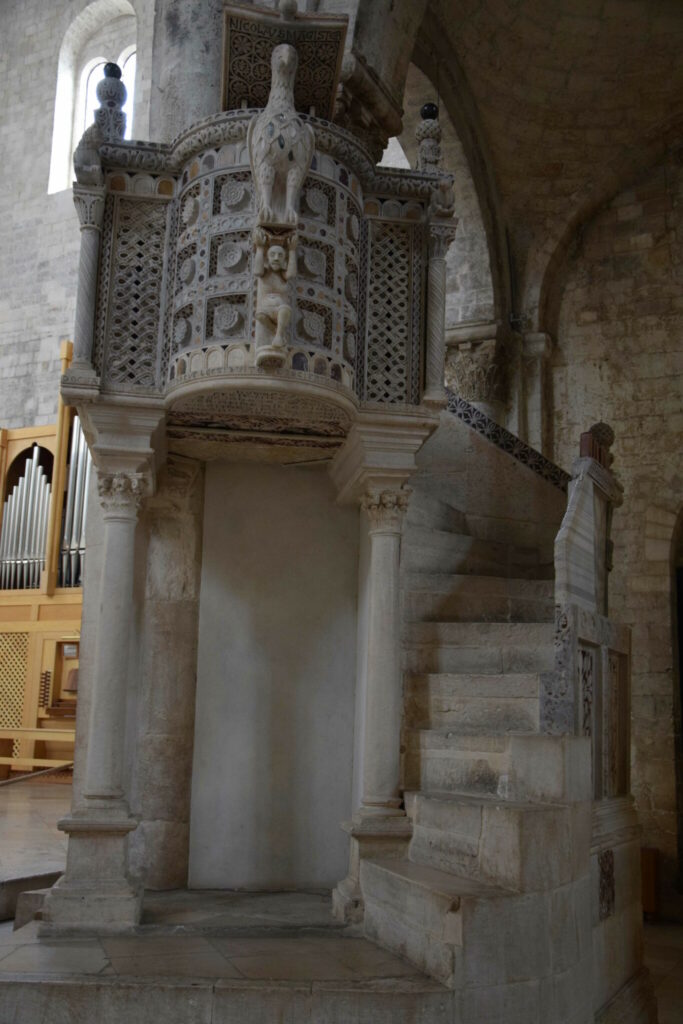
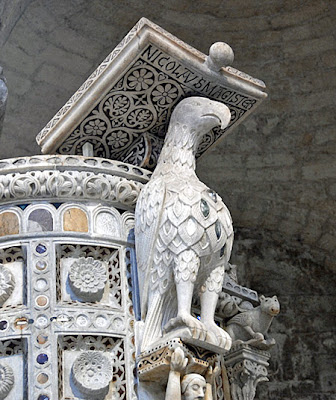
Excavations have revealed remains of earlier churches, on the site of which the present cathedral was built, including a whole floor of a previous church, essentally buried when the present church was constructed three metres above it. These remains, including some arcaded sections, are now incorporated into the crypt. Entrance to the cathedral itself is free of charge, but there is a charge for going down to see the crypt, and access is anyway often unavailable. That is the bad news, now for the good news. The main reason for going to the crypt is to see the magnificent mosaic griffin in the floor, which is one of the main symbols of Bitonto. Fortunately for casual visitors, a glass covered opening in the cathedral floor allows the griffin to be seen perfectly three metres below, usually illuminated so its features can be fully appreciated.
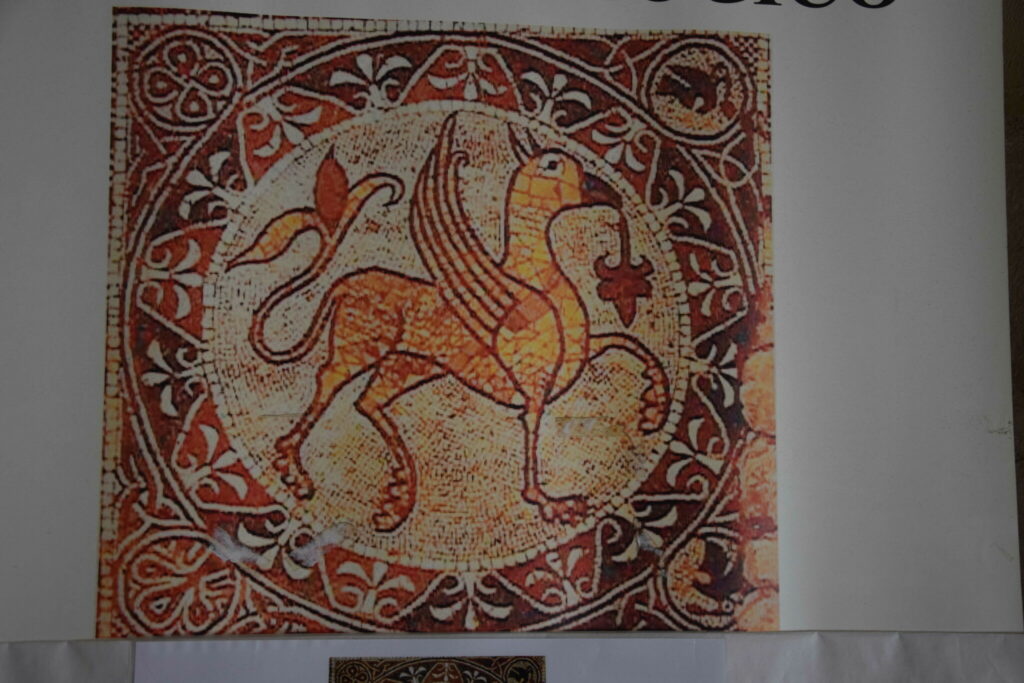
Don't miss this interesting spectacle. The griffin dates from the Byzantine period. it is a mythical beast, a combination of an eagle (representing the sky) and the lion (representing the earth). It also has limbs which combine references to the plant and animal worlds. In mediaeval times it was regarded as a symbol of Christ as creator of the world.
Opening times for the cathedral are:
Friday - Monday: 10.00 - 12.30/15.30 - 18.00
Archaeological Museum
There is an archaeological museum in Bitonto run by the De Palo-Ungaro Foundation. This opened in 2000. It is small and somewhat specialist. It is very well presented with maps, charts and explanations (all in Italian), featuring two permanent exhibitions, “The Ancient Peuceti in Bitonto” and “Women and Warriors from Ruvo and Bitonto”. Exhibits date from the 6th-3rd century BC and all come from ancient local burial grounds discovered along the route of the “Via Traiana”. The numerous decorated funerary objects are very attractive and well displayed. They demonstrate the economic and social development of the Peuceti civilization which operated in northern Puglia in the Iron Age.
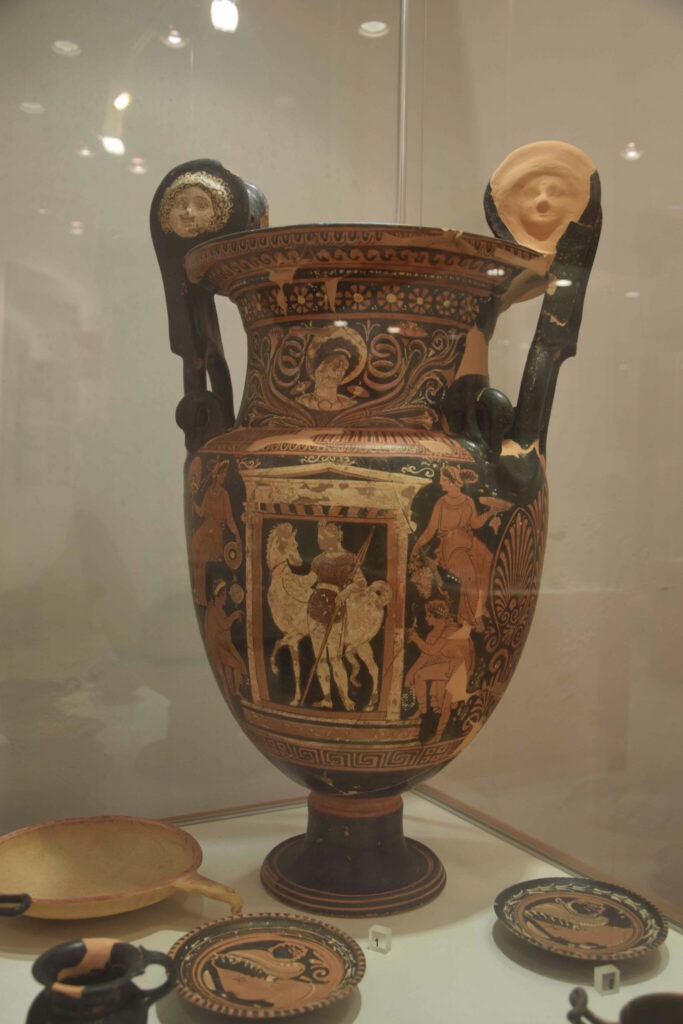
The museum is located in a side street in the 19th quarter of the city, about halfway between the station and the Piazza Cavour, so it is reasonably covenient to visit it if arriving by train. Unless you have a particular interest, it does not take very long to see what is there. Opening hours are limited, basically weekday mornings, so if you defintely want to go check on their website. If it seems to be closed, knock on the door, it is run fairly casually by volunteers. Admission is free.
Bitonto's "ring road"
A unique feature of Bitonto is not visible to visitors to the city but is totally obvious on the map of the area - an almost perfectly circular ring road.
This strange feature, which is really just a track or lane for much of its length, was conceived and constructed in 1946-48 by the Director of Roads for the area, Guiseppe Cazzolla. Bitonto is surrounded by an important olive growing area, and the intention was to ease the movement of agricuktural vehicles (tractors and carts) around the city without clogging up the radial roads. It subsequently got integrated inot the local minor road system. The radius is precisely 3 km from the centre of Btonto. The circle is not quite complete, probably because the need to bridge a ravine proved too expensive.
Some practicalities for visitors
From day visits and overnight stays by family members, we are reasonably familiar with Bitonto. the city can definitely be recommended as a visitor destination. It has a lot to offer, and subject to opening hours its key "sights" can be covered within a day or less.
However, despite its very significant attractions, Bitonto is hardly geared up for tourists. This has good and bad points. There are practically no shops or stalls selling "tourist trash" except for some local food specialities, olive oil especially (for which Bitonto is well known). It is also rarely crowded, even in summer. However, there are hardly any displayed maps of the town to guide visitors, and the few you will encounter are badly located and hard to read. There are some signs on the streets, but not many explanatory information boards on buildings (which are otherwise fairly common throughout Puglia).
There is a very limited tourist information office. It is located up a flight of steps just inside the courtyard of the Biblioteca Communale - this is in the borgo vecchia, just beyond the Chiesa del Pugatorio (there are signs to it), and the buildng itself is of interest, have a look around it if you can. We have never needed to find any staff, but there are various leaflets and small simple maps of the city which you can just pick up; we would suggest getting a map to help find you way around.
If you want to have a meal in Bitonto, it would be as well to look somewhere up online beforehand if you can. There are a few restaurants, but not many, so if you rely on hoping to encounter somewhere open, you riskl disappointment. There are several bars, coffee shops and patisserie, again not in large numbers, but there are a couple of good ones in Piazza Cavour. We do not usually recommend places, but Il Solito Posto in a corner of Piazza Cavour behind the Torrione is reliable at most times of the day - it operates indoors and outside, as a pub, wine bar, snack bar and decent good value restaurant, with friendly and helpful staff.
